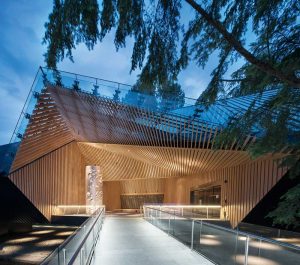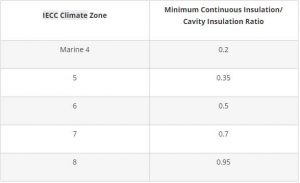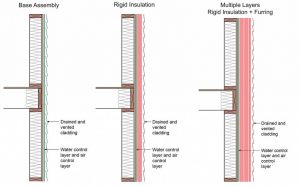by Peter Barrett

It has been said before, but bears repeating: as much as 80 percent of premature building wear expenses are related to moisture in one way or another. Water is the most significant factor in the premature deterioration of buildings, as it can cause corrosion of metals, rotting and mold in organic substances, dissolution of materials, reduction in effectiveness of insulation,
and more.
Building industry professionals largely agree on the importance of moisture control methods, but there is frequent confusion about the use of vapor and air barriers. To make the right decision on which methods and materials to include in a building envelope, it is critical to understand the simple, yet significant, differences between air and vapor barriers, and their role as part of an effective system.
Air barrier function

Images © Joe Lstiburek
An air barrier’s function is primarily to stop air leakage and resist differences in air pressure by keeping the indoor climate regulated. Simply put, air barriers keep the outdoor air out and the indoor air in. An air barrier should be:
- durable enough to withstand construction pressures and handling;
- impermeable to airflow; and
- continuous, enclosing, or enveloping the entire conditioned space.
While air barriers are key to limiting the airflow in and out of a living space, it is important to note air from either a conditioned or an unconditioned side may still find its way into walls. So, even though it is critical for a living space to have walls that are as airtight as possible, the assembly of the wall itself should always be moisture vapor permeable to allow for incidental moisture to escape, or diffuse, rather than be trapped and make the structural materials of the wall wet.
A vapor barrier’s most important function, on the other hand, is to be impermeable to moisture in vapor form, thereby preventing the movement of water vapor through the wall cavity from going outside, and vice versa. While this notion sounds simple, it is not.
Effects of rainwater penetration through walls

One of the trickiest elements coming into the wall from the outside is rainwater (also known as bulk water), which almost always causes trouble. Most significant would be the issues caused by water moving inward and reaching the vapor barrier where it gets trapped, causing catastrophic failure of the wall in the form of rot and mold. One feasible solution is to eliminate the vapor barrier altogether, allowing the wall to dry from both sides, thereby creating a flow-through assembly. While it may be possible in many cases, the elimination of the vapor barrier is not always an option.
Leaving out the vapor control layer is only possible in structures with non-extreme environmental loads and continuous insulation (ci) on the outside. As noted by building industry educator Joe Lstiburek, a non-extreme environmental load essentially means a building enclosure on an office, house, or apartment as opposed to the façade of a natatorium, museum, hospital, or art gallery. The enclosures subjected to an extreme environmental load are operated at high interior humidity (50 percent or higher year round) and are pressurized. Therefore, for natatoriums, museums, hospitals, or art galleries, a wall incorporating a vapor barrier layer to the interior is essential to maintain moisture vapor impermeability.
Some restrictions come into play for non-extreme environmental loads without ci on the outside. In colder climates, some kinds of interior ‘vapor throttles’ are required. A vapor throttle is essentially the component with the lowest moisture vapor permeability compared to the rest of the elements of the wall. This component tends to establish the overall moisture vapor permeability of the wall system. The International Energy Conservation Code (IECC) specifies climate zones 6 and higher as requiring a vapor control layer (Figure 1). In these cases, a ‘smart’ vapor barrier (a material whose moisture vapor permeability increases when relative humidity [RH] is high and decreases when RH is low), which works without the need for ci in such climate zones (6 or higher), can be used as well.





Most of the confusion in building envelope functionality is caused by manufacturers who mislead and blur the line between their products and its supposed function. It’s ironic when this happens on Construction Specifier, but this is still rampant on most “building science” sources.
I’ve found the most helpful distinction is 5 specific barriers:
1. Bulk water (rain, sprinklers)
2. Moisture (wind blown droplets, condensation)
3. Air (dry)
4. Humidity (the moisture in air)
5. Thermal (temperature)
Yes, some products serve multiple purposes, but I have seen Moisture and Air confused more often then described correctly. For example, any product that absorbs moisture within the time it takes for typical exterior envelope drying (3-5 days of dry weather) is actually not a barrier to moisture.
Peter – Very nice article.
Wagdy Anis (RIP) – would refer to an air barrier as an Air and Water barrier or in the day – sheet rubberized asphaltic or butyl barrier (SRAB/SRBB), and a vapor barrier not as a barrier at all, rather a retarder. “there can be thousands of holes in a vapor retarder assembly in a building enclosure, and the retarder would work effectively. It is not necessary for a vapor retarder assembly to be installed/sealed air tight”.
I continue to believe that Wagdy had it right, in using the term retarder for vapor control assemblies. Delineating building enclosure key components as retarders and barriers provides clarity for the building enclosure designer, notwithstanding IECC continues to use both terms.